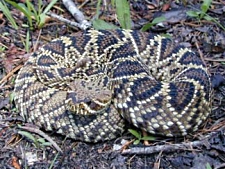Wildlife - Species

Eastern Diamondback Rattlesnake (Crotalus adamanteus)
Description
The eastern diamondback rattlesnake is the largest of its species in the world and the most venomous snake in North America. It has a distinct coloration pattern consisting of dark diamond-shaped dorsal blotches defined by a border of yellowish scales. A dark bar bordered by two yellowish white stripes on either side extends back at an angle from the snake's mouth to its eye. The characteristic "rattle" comes from a series of loosely attached segments at the end of the tail. The buzzing noise is created when the snake rapidly vibrates its tail.
Preferred Habitat and Biology
The eastern diamondback rattlesnake inhabits coastal lowlands from southeast North Carolina to the Florida Keys. It is also found as far west as the eastern portion of Louisiana. Its preferred habitat is the longleaf pine ecosystem, which is currently endangered. Longleaf pine forests are rapidly being converted to loblolly pine plantations and urban areas, thus threatening the existence of the eastern diamondback rattlesnake. Removal of tree stumps is a particular threat to the snakes, which use the stumps as refuge.
This species of rattler is holothermal; that is, it is ready to capture prey during all times of day. It is most active during the day and at dusk, feeding primarily on rabbits and rats and occasionally on mice, squirrels, and birds. Its dietary preference makes this species important in controlling populations of rodents which, if too high, can harm other species such as ground nesting birds. The breeding season for this species extends from August to September. The eastern diamondback rattlesnake is a viviparous snake; that is, a female gives birth to live young. This occurs in the fall, every two to three years, with average brood size ranging from 6 to 21. After the breeding season is over, rattlers resume foraging for prey and return to over-wintering locations. The coldest months of the year are spent in underground shelters.
Species Significance
According to a recent proposal by the Convention on the International Trade in Endangered Species (CITES), the eastern diamondback rattlesnake has been ignored in conservation efforts until recently. This situation likely results from the to "the sociological problems inherent in any conservation effort directed at a venomous species that threatens human life." In South Carolina, the eastern diamondback rattlesnake is listed as a Species of Concern, and its ecology is being studied by the Wildlife Diversity Section of the South Carolina Department of Natural Resources. Collection, sale, and purchase of this species is allowed in South Carolina without restrictions, and its status as a Species of Concern does not provide any legal protection.
References
Behler, J. L., King, F. W. 1985. The Audubon Society Field Guide to North American Reptiles and Amphibians. Alfred A. Knopf, Inc. New York, New York.
Bennett, S. H. 1995. Ecology and status of the eastern diamondback rattlesnake (Crotalus adamanteus) in South Carolina. South Carolina Department of Natural Resources, Columbia, SC.
Martof, B. S., Palmer, W. M., Bailey, J. R., Harrison III, J. R. 1980. Amphibians and reptiles of the Carolinas and Virginia. The University of North Carolina Press, Chapel Hill.
